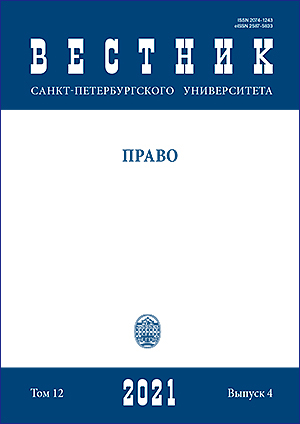Legal means of effective rehabilitation of a debtor or its enterprise in restricting procedures in Russia and Germany
DOI:
https://doi.org/10.21638/spbu14.2021.420Аннотация
The article analyzes the legal means of rehabilitation during the extrajudicial procedure for restructuring an enterprise in German law, as well as the provisions of the Russian law draft that introduces a similar judicial procedure. The purpose of this study is to formulate the main provisions of the rehabilitation procedures of insolvency (bankruptcy) in the national Russian legislation on the basis of the normative regulation and doctrinal concepts prevailing in Germany, where both debtor and his enterprise can be rehabilitated. The main research methods used were comparative legal and historical legal methods in combination with the systematic method. The methods of synthesis, interpretation, and the teleological method were also used to assist in selecting the appropriate legal means to achieve the goal of rehabilitating the debtor or his enterprise. The legal nature of the law of the restructuring plan is analyzed as well as its main elements and the procedure for adoption and approval that takes into account creditors’ interests of. It is concluded that rehabilitation can be carried out in the form of extrajudicial rehabilitation both within the framework of a special procedure and in a free form on the basis of an agreement between the debtor and his creditors in regard to debt restructuring. The legal means of reorganization of the debtor and his enterprise are highlighted. It is substantiated that the Russian legislation needs to change its concept of rehabilitation procedures. First of all, it is necessary to complement the goal of rehabilitation procedures by translatable rehabilitation if the debtor cannot be rehabilitated and to use appropriate legal means of stabilizing and preserving the debtor’s business or part of it to minimize the negative consequences of insolvency.
Ключевые слова:
insolvency, inability to pay, restructuring procedure, rehabilitation, replacement of assets, sale of an enterprise, forms of rehabilitation, extrajudicial procedures
Скачивания
Библиографические ссылки
Загрузки
Опубликован
Как цитировать
Выпуск
Раздел
Лицензия
Статьи журнала «Вестник Санкт-Петербургского университета. Право» находятся в открытом доступе и распространяются в соответствии с условиями Лицензионного Договора с Санкт-Петербургским государственным университетом, который бесплатно предоставляет авторам неограниченное распространение и самостоятельное архивирование.






